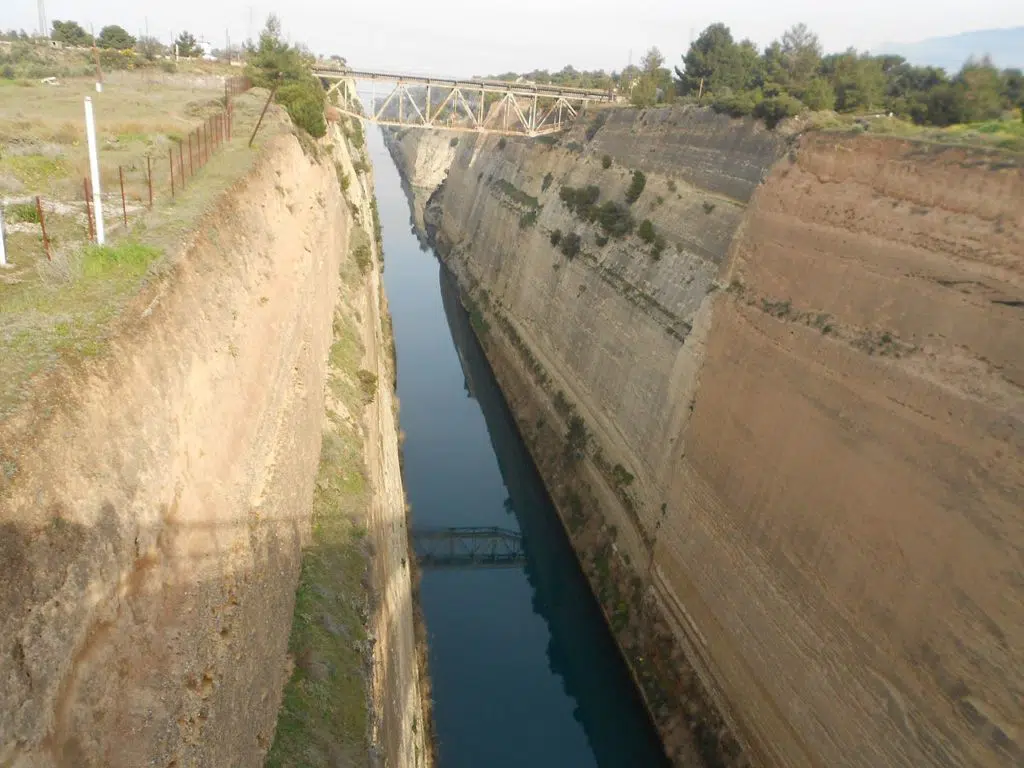
The Corinth Canal in Greece is one of the most important infrastructures in the entire nation, yet it has been shut for a year now due to landslides that occurred last February.
Also known as the Isthmus of Corinth, the canal connects the Ionian and the Aegean Seas, making the passage of cargo and passenger ships between the two much quicker and safer.
In February 2021 a landslide forced authorities to stop the operation of the Corinth Canal. Restoration works started, but in July new landslides put a stop to the works altogether.
According to the Ministry, a volume of 15,000-20,000 square meters (215,278 square feet) of rock from the side of the Peloponnese fell into the canal.
An official Ministry of Environment and Energy decision in January stated that restoration works for the damage to the Corinth Canal would commence.
By the same decision, within two years, the officials responsible for the operation of the Corinth Canal will have to comply with the requirements of the environmental licensing legislation for the overall restoration project.
“We expedite procedures so that the restoration work can begin immediately, in January 2022, while at the same time we ensure the protection of the environment, through appropriate measures.
“The Corinth Canal is a project of global interest, a point of reference and it is no coincidence that it has been characterized by the Ministry of Transport and Infrastructure as a Complex and Special Project of National Interest,” Environment and Energy Deputy Minister, Nikos Tagaras said.
History of the Corinth Canal
Opened on July 25, 1893, the Corinth Canal is one of the most important infrastructure works of the modern Greek State, instantly changing all major maritime activity in the country.
Construction works started in 1882 and the canal was inaugurated by then Prime Minister Sotirios Sotiropoulos. Yet it was completed by his predecessor Charilaos Trikoupis whose term had ended only two months before that date.
Before the canal was built, ships from the Ionian Sea with the destination of Athens or the Aegean islands had to go all around the Peloponnese peninsula and vice versa.
After 1893, cargo and passenger ships would only have to cross the Isthmus of Corinth and reach their destination much quicker.
Ancient Corinth
The word “isthmus” comes from the Ancient Greek word for “neck” and refers to the narrowness of the land.
The idea for a shortcut to save boats sailing all round the Peloponnese was considered by by ancient Greeks as early as the 7th century BC.
The tyrant Periander started working on the project to connect the Peloponnese peninsula with mainland Greece.
Technical difficulties forced the abandonment of the Corinth Canal project very quickly, however. A simpler and less costly overland stone ramp, called the Diolkos, was built as a portage road.
Remnants of the Diolkos still exist today next to the modern canal.
When the Romans came, a number of different solutions were tried in order to create a canal. Julius Caesar foresaw the advantages of a link for his newly built Colonia Laus Iulia Corinthiensis.
During the rule of Tiberius, engineers tried to dig a canal but could not manage to finish due to lack of equipment.
Instead, they used an ancient Egyptian device: boats were rolled across the isthmus on logs, as the Egyptians had rolled blocks of granite to build the pyramids.
In 67 AD, Roman emperor Nero ordered 6,000 slaves to dig a canal using spades. Historian Flavius Josephus writes that the 6,000 slaves were Jewish pirates, taken captive by Vespasian during the Jewish wars.
According to Pliny the Elder, the work advanced four stadia (about 0.8 kilometers). The following year Nero died, and his successor Galba abandoned the project as being too costly.
Building the canal in the 19th century
In the modern era, the idea was first seriously proposed again in 1830, soon after Greece’s independence from the Ottoman Empire. Greek statesman Ioannis Kapodistrias hired a French engineer to draft a plan.
The project would cost a steep 40 million gold francs, a prohibitive amount of money that forced the first Greek government to abandon it.
Later, inspired by the construction of the Suez Canal, Prime Minister Thrasyvoulos Zaimis signed a law in 1870 that authorized the engineering project of the Corinth Canal.
A French company oversaw the project that resulted in the construction phase starting and soon after ending — again due to cost issues.
The dream of the Corinth Canal would finally become a reality when in 1881, the Société Internationale du Canal Maritime de Corinthe was commissioned to construct the canal and to operate it for the next 99 years.
Construction began in April 1882; however, eight years later, Greece ran out of money. This time, a Greek company stepped in and the canal was finally completed in July 1893.
To the west of the Isthmus is the Gulf of Corinth, to the east the Saronic Gulf. Since 1893 the Corinth Canal has run through the 6.3 km wide canal, effectively making the Peloponnese an island.
Today, two road bridges, two railway bridges and two submersible bridges at both ends of the canal connect the mainland side of the isthmus with the Peloponnese side. A military emergency bridge is also located at the west end of the canal.
See all the latest news from Greece and the world at Greekreporter.com. Contact our newsroom to report an update or send your story, photos and videos. Follow GR on Google News and subscribe here to our daily email!



